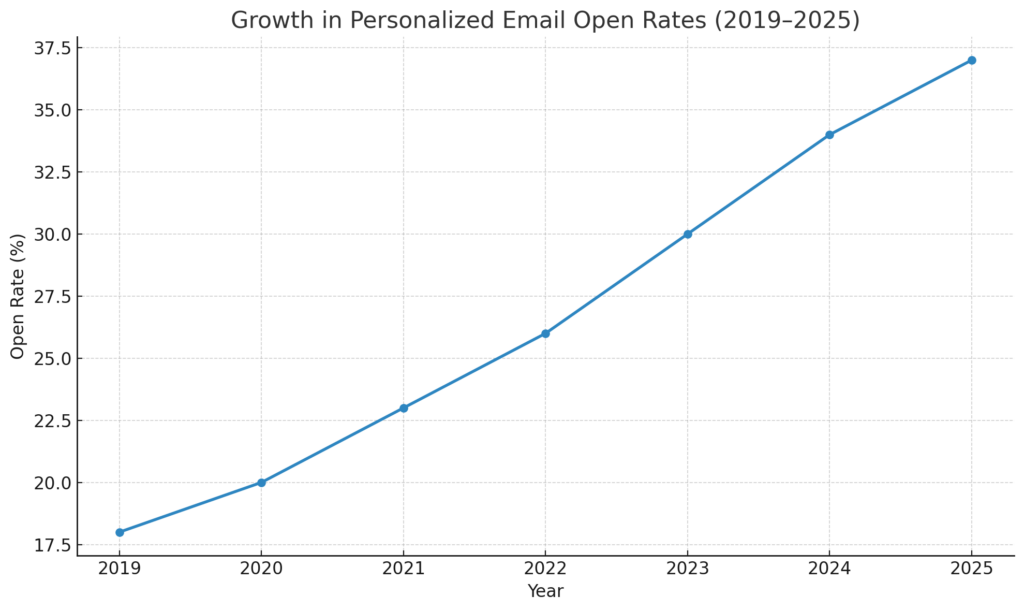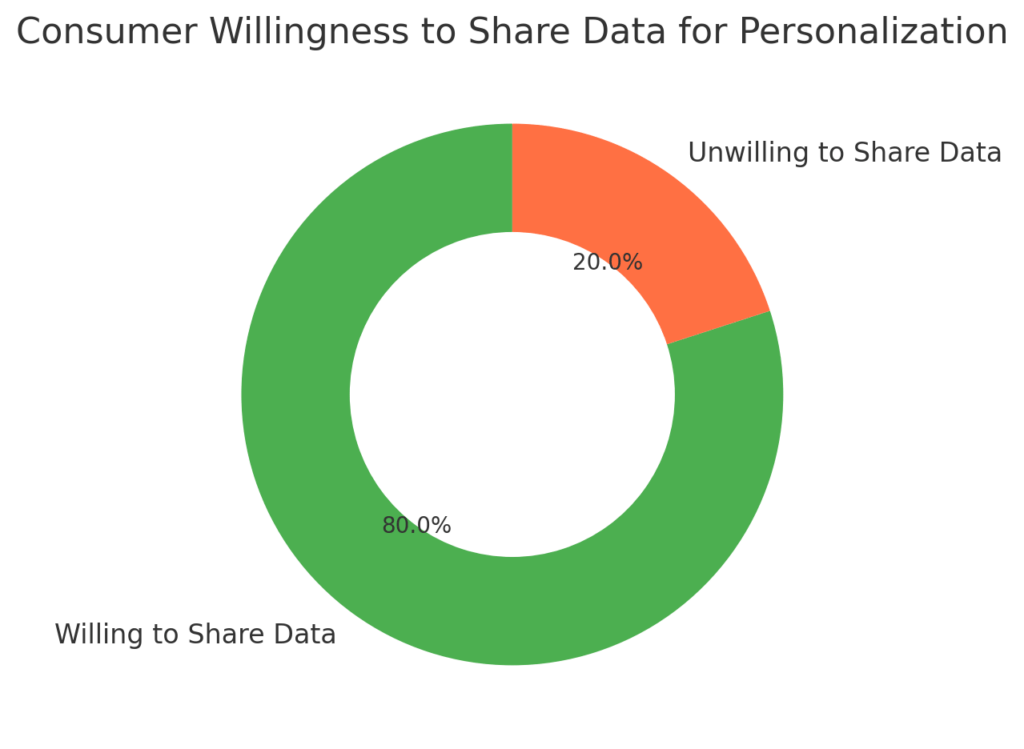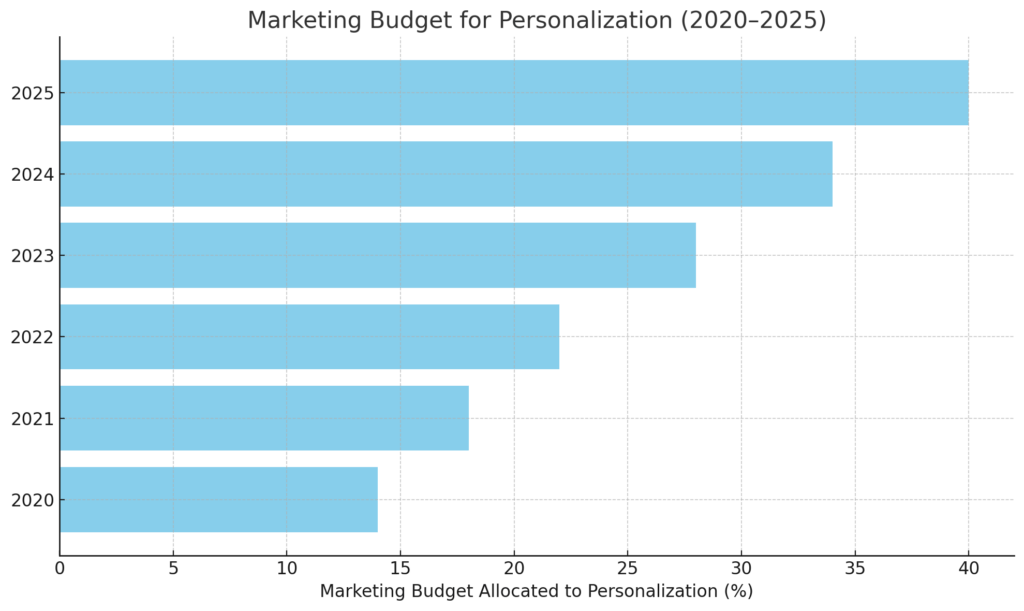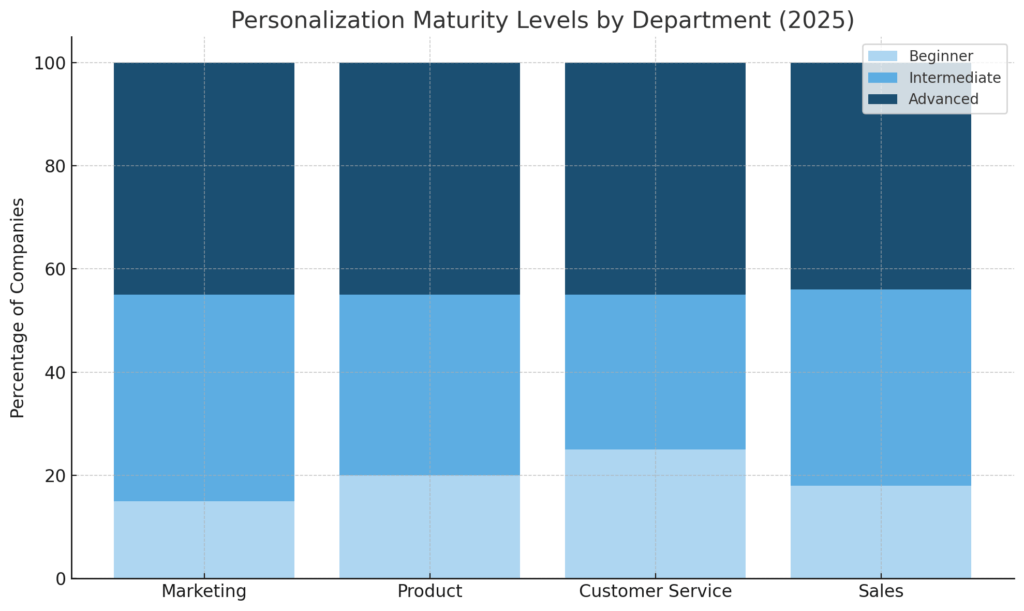
31 Mar BEST PERSONALIZATION IN MARKETING STATISTICS 2025
Personalization has evolved from a marketing buzzword into a core expectation—and in 2025, it’s defining how brands connect, convert, and keep their customers. As digital competition intensifies and consumers demand more relevance in every interaction, personalization has become the line between being ignored and being chosen. It’s not just about adding a first name to an email; it’s about delivering experiences that feel timely, intuitive, and uniquely human at scale.
Marketers across every industry are responding, increasing budgets, upgrading tools, and rethinking how they use data. But behind the strategies are the numbers that show where personalization has been—and where it’s headed. Amra and Elma presents these 20 statistics to capture the momentum, challenges, and future implications of personalization in marketing, offering a data-backed look at what’s working, what’s expected, and what’s next.
BEST PERSONALIZATION IN MARKETING STATISTICS 2025 (Editor’s Choice)
Personalization in marketing has become increasingly vital, with numerous studies highlighting its impact on consumer engagement and business performance. Below are 20 key statistics that underscore the significance and evolution of personalization in marketing, both historically and projected for 2025:
1. Personalization Seen as Key to Business Success
89% of marketing decision-makers say personalization is essential for success over the next three years, showing it’s now a strategic imperative—not just a tactic.
2. Gap Between Brand Perception and Customer Experience
While 85% of companies believe they personalize well, only 60% of customers agree, exposing a major disconnect that could cost loyalty.
3. Executives Prioritize Personalization in Digital Strategy
75% of company executives see personalization as critical to delivering strong digital experiences, pushing it to the center of long-term planning.
4. Personalization Software Market Approaching $10B
By 2024, global revenue for personalization and optimization tools is set to surpass $9.5 billion, signaling continued growth in data-driven marketing.
5. Top Marketers Link Personalization to Profit Growth
90% of leading marketers report that personalization significantly improves business profitability, proving its bottom-line impact.
6. Consumers Expect Personalization—and React When It’s Missing
71% expect tailored interactions, and 76% feel frustrated without them, making personalization the baseline for satisfaction.
7. High Personalization Drives 40% More Revenue
Brands that personalize effectively generate 40% more revenue than those that don’t, revealing a powerful link between relevance and results.
8. Marketers See Personalization as Biggest Opportunity
51% of marketers say improving personalization is their top growth lever, reflecting where innovation is focused in 2025.
9. Personalization Programs Reaching Maturity
73% of executives and 61% of senior managers say their programs have matured, setting the stage for deeper, more integrated efforts.
10. Majority of Leaders Increasing Personalization Spend
74% of digital marketing leaders are investing more in personalization, showing growing commitment to better consumer targeting.
11. Marketing Budgets for Personalization Nearly Double
Marketers now allocate 40% of their budget to personalization—up from 22% in 2023—demonstrating its expanding role in strategic planning.
12. Consumers Prefer Brands with Relevant Recommendations
91% say they’re more likely to shop with brands offering relevant suggestions, making personalization a conversion tool, not just a loyalty play.
13. Personalization Reduces Costs and Boosts Revenue
Marketing strategies that are personalized can cut customer acquisition costs by up to 50% while increasing revenue by 5–15%.
14. Most Consumers Engage Only with Personalized Content
72% of consumers exclusively interact with personalized messaging, reinforcing its value across email, ads, and websites.
15. Personalization Drives Repeat Customer Behavior
60% of consumers say they’re more likely to return after a personalized experience, linking relevance to long-term loyalty.
16. Consumers Will Share Data for Personalized Value
80% are willing to trade personal data for tailored deals or content, as long as brands handle it with transparency and care.
17. Recommendation Engine Market Set to Hit $12B
By 2025, the recommendation engine industry is expected to reach $12 billion, powering smarter content and product suggestions.
18. Personalization Software Already Near $1B Market
The market was valued at $943 million in 2022, laying the foundation for advanced tools becoming essential in marketing stacks.
19. Improving CX is Marketers’ Top Personalization Goal
88% of marketers say the main purpose of personalization is enhancing customer experience—not just boosting clicks or conversions.
20. Poor Personalization Pushes Consumers Away
63% of consumers say they’ll abandon a brand that doesn’t personalize well, making relevance a survival factor in 2025.
These statistics highlight the growing importance of personalization in marketing strategies, emphasizing its role in enhancing customer satisfaction, loyalty, and overall business success.
BEST PERSONALIZATION IN MARKETING STATISTICS 2025 and Future Implications
BEST PERSONALIZATION IN MARKETING STATISTICS 2025 #1. 89% of Marketers Say Personalization Is Essential
This stat shows how deeply personalization has become embedded in the future of digital marketing strategy. When nearly nine out of ten decision-makers see it as vital, it’s no longer a trend—it’s a baseline expectation. Brands that ignore this will struggle to remain competitive in markets where customized experiences build loyalty and conversion.
As we head deeper into 2025, this suggests a greater shift toward dynamic content, AI-driven product suggestions, and behavior-based targeting. Marketers will need more granular data and flexible infrastructure to execute these strategies at scale. Those who adapt early can outperform competitors and create more emotionally resonant customer journeys.
BEST PERSONALIZATION IN MARKETING STATISTICS 2025 #2. 85% of Brands Think They Personalize—Only 60% of Customers Agree
The gap between perception and reality here highlights a serious disconnect. While brands think they’re doing a good job personalizing, a large chunk of their audience feels otherwise. That’s a red flag for marketers relying on outdated or surface-level personalization methods like “Hi [First Name]” in emails.
For 2025, this disconnect suggests a need for real-time data integration and customer feedback loops to close the satisfaction gap. Companies that can align internal beliefs with external experience will not only build trust but also unlock more impactful results from their campaigns. Transparency, relevance, and responsiveness will become the key differentiators in personalization.
BEST PERSONALIZATION IN MARKETING STATISTICS 2025 #3. 75% of company executives view personalization as essential for digital experiences.
Executive buy-in is one of the clearest signs that personalization is a core strategic priority, not just a tactical add-on. When three-quarters of top leaders believe it’s essential, budgets and resources are likely to follow. In 2025, this will likely translate into more C-suite support for experimentation with AI tools, deeper data investments, and specialized hiring around personalization.
Companies that prioritize this from the top-down are better positioned to adapt to real-time customer needs. It also signals the rise of personalization as part of long-term brand equity—not just short-term conversion plays. The future of marketing will depend on seamless personalization woven into every digital touchpoint.
BEST PERSONALIZATION IN MARKETING STATISTICS 2025 #4. By 2024, the global revenue of customer experience personalization and optimization software is projected to surpass $9.5 billion.
That kind of market value reflects the growing demand for software that can adapt experiences based on user behavior, context, and preferences. As businesses scale personalization, automation and data tools become indispensable. This growth sets the stage for continued innovation in 2025, with personalization platforms expected to integrate more deeply with CRMs, analytics tools, and even AR/VR environments.
The projected revenue also reflects global adoption, meaning personalization is no longer concentrated in mature markets—it’s everywhere. Brands investing in robust software solutions now will be better prepared to create consistent, cross-channel experiences. The growth also opens doors for startups that offer niche personalization features, especially for mid-size brands.
BEST PERSONALIZATION IN MARKETING STATISTICS 2025 #5. 90% of leading marketers say personalization significantly contributes to business profitability.
Profitability is the ultimate measure of marketing effectiveness, so this stat connects personalization directly to the bottom line. Leading marketers aren’t just seeing personalization as a nice-to-have—they’re quantifying its financial return.
For 2025, this means personalized strategies will likely get top billing in marketing plans and performance reports. From upselling to retention, personalized offers and content are proving more persuasive and cost-effective. As consumer expectations rise, generic messaging won’t cut it. The brands that succeed in 2025 will be the ones turning data into dollars through emotionally intelligent, personalized touchpoints.
BEST PERSONALIZATION IN MARKETING STATISTICS 2025 #6. 71% of consumers expect companies to deliver personalized interactions, and 76% get frustrated when this doesn’t happen.
This stat reflects the rising bar consumers have set for personalization in 2025. It’s no longer just a nice bonus—people actively expect tailored experiences, and their patience for generic messaging is wearing thin. The frustration metric is especially telling because it shows that failure to personalize isn’t just neutral—it’s damaging.
For marketers, this creates pressure to build responsive, adaptive systems that learn and evolve with each user. Companies that rely on outdated segmentation or one-size-fits-all strategies are risking not just lower conversion, but churn. Looking ahead, personalization will be as essential to brand reputation as customer service once was.
BEST PERSONALIZATION IN MARKETING STATISTICS 2025 #7. Companies that excel at personalization generate 40% more revenue from those activities than average players.
This performance gap shows just how powerful personalization can be when done well. A 40% revenue increase isn’t marginal—it’s transformative. It implies that the top-performing companies aren’t just using data—they’re using it intelligently, tailoring every stage of the funnel to individual behavior.
As AI tools become more accessible in 2025, we’ll likely see more companies striving to close that gap. The key will be moving beyond basic demographic targeting toward behavioral, contextual, and even predictive personalization. Those who succeed can grow faster with fewer wasted impressions and stronger customer retention.
BEST PERSONALIZATION IN MARKETING STATISTICS 2025 #8. 51% of marketing professionals say that creating a more personalized customer experience is the top opportunity.
More than half of marketers are putting personalization at the top of their opportunity list, showing how it’s shifting from experimentation into core growth strategy. This stat signals a broader awareness that personalization isn’t just reactive—it’s a proactive tool for engagement, conversion, and loyalty.
Heading into 2025, expect this focus to fuel investment in tools like customer data platforms (CDPs), machine learning, and real-time content delivery. It also suggests personalization will influence everything from creative direction to UX design. As marketing budgets tighten or become more performance-driven, the pressure to personalize in ways that drive measurable outcomes will only grow.
BEST PERSONALIZATION IN MARKETING STATISTICS 2025 #9. 73% of executives and 61% of senior managers describe their personalization programs as achieving maturity.
This is a strong indicator that personalization has moved out of its pilot phase in many organizations. A mature program means systems are in place, goals are clear, and teams are aligned. By 2025, this level of maturity will allow companies to scale personalization more strategically, going beyond email to fully integrated omnichannel campaigns.
However, maturity also comes with risk: stagnation. Brands that don’t continue innovating or experimenting may fall behind newcomers who adopt newer AI-driven personalization methods. Staying competitive in 2025 will mean treating maturity as a foundation, not a finish line.
BEST PERSONALIZATION IN MARKETING STATISTICS 2025 #10. 74% of digital marketing leaders are increasing their investment in personalization.
This investment trend shows that personalization isn’t just working—it’s working well enough to warrant even more attention. As companies head into 2025, we’ll likely see a surge in AI-powered personalization engines, real-time content systems, and cross-platform data syncs. Leaders are clearly seeing ROI and are doubling down, which may widen the performance gap between brands that invest and those that don’t.
It also points to growing internal competition for customer attention, where the most personalized brand wins. As channels diversify—think smart TVs, wearables, and voice platforms—this investment will drive personalization into new environments. That means marketers must prepare to customize not just content, but context.
BEST PERSONALIZATION IN MARKETING STATISTICS 2025 #11. Marketers now allocate approximately 40% of their budgets to personalization, nearly double the 22% allocated in 2023.
This dramatic increase in budget allocation signals a serious prioritization of personalization across the board. Going from 22% to 40% in just two years shows that brands are no longer treating personalization as a side initiative—it’s becoming the backbone of digital marketing. In 2025, this trend suggests larger cross-functional collaboration, as personalization influences content creation, data science, customer support, and product design.
It also points to growing demand for tools that unify customer data, automate decision-making, and enable real-time responses. As more money flows into this space, the industry will likely see more innovation in tools that offer scale without sacrificing precision. The brands best positioned to win will be those that treat personalization not as a line item, but as a mindset.
BEST PERSONALIZATION IN MARKETING STATISTICS 2025 #12. 91% of consumers say they are more likely to shop with brands that provide offers and recommendations relevant to them.
This stat shows how closely personalization is tied to consumer loyalty and purchasing behavior. Shoppers don’t just like tailored experiences—they actively prefer and reward them. In 2025, this makes relevance the deciding factor in conversion paths, especially for eCommerce and DTC brands.
With so many options available, consumers won’t waste time on generic offers—they’ll move toward brands that make them feel understood. That puts pressure on marketers to use data more intelligently, whether through purchase history, browsing behavior, or AI-generated recommendations. The future isn’t about more content—it’s about smarter, more meaningful content delivered at exactly the right moment.
BEST PERSONALIZATION IN MARKETING STATISTICS 2025 #13. Personalization marketing can reduce customer acquisition costs by as much as 50% and lift revenue by 5% to 15%.
This stat makes the financial case for personalization crystal clear. Reducing acquisition costs while increasing revenue is the ultimate marketing efficiency equation. In 2025, this will push more brands to shift budget from broad awareness campaigns to precision-targeted experiences that optimize every interaction.
Lower CAC also means more room to test creative strategies, expand into niche markets, and improve lifetime value per customer. It emphasizes that personalization isn’t just about tech—it’s about business sustainability. Companies that embed this into their entire customer journey—from first click to loyalty program—will stretch their dollars further and grow smarter.
BEST PERSONALIZATION IN MARKETING STATISTICS 2025 #14. 72% of consumers exclusively engage with personalized messaging.
This number reveals how deeply embedded personalization has become in consumer behavior. It’s not just a preference—it’s a threshold. In 2025, generic messaging will increasingly fall flat, ignored by audiences who expect brands to know them. This stat underlines the importance of dynamic content generation, adaptive messaging, and personalization tools that can react in real time.
Brands will need to build more flexible campaign structures that can accommodate user behavior shifts on the fly. If nearly three-quarters of your audience won’t engage without personalization, then the question is no longer “Should we?” but “How fast can we scale it?”
BEST PERSONALIZATION IN MARKETING STATISTICS 2025 #15. 60% of consumers say they’ll become repeat customers after a personalized shopping experience.
Retention is where profitability lives, and this stat shows personalization is the key to unlocking it. A personalized experience makes customers feel seen, which drives not only conversion but long-term loyalty. In 2025, that means brands must go beyond transactional personalization—like product suggestions—and explore deeper layers, such as emotional tone, timing, and messaging relevance.
Loyalty programs and post-purchase communications will increasingly depend on how well the brand continues tailoring experiences after the first sale. The takeaway is clear: personalization isn’t just a way to get the sale—it’s how you keep the customer coming back.

BEST PERSONALIZATION IN MARKETING STATISTICS 2025 #16. 80% of consumers will share personal data in exchange for deals or offers.
This reflects a clear value exchange—when consumers trust a brand, they’re willing to provide data in return for personalized value. In 2025, that means marketers have a green light to deepen personalization strategies, provided they’re transparent and respectful with data usage. The opt-in nature of this exchange places ethical responsibility on brands to protect and actively use that data to enhance the user experience.
As privacy regulations evolve, those who build strong consent frameworks and clearly communicate value will gain a competitive edge. The future of personalization lies in trust: the more trustworthy the brand, the more personalized it can become. This opens doors to richer, more contextual interactions that feel helpful rather than invasive.
BEST PERSONALIZATION IN MARKETING STATISTICS 2025 #17. The recommendation engine market size is projected to hit $12 billion by 2025.
Recommendation engines are at the heart of scalable personalization—powering everything from eCommerce suggestions to content feeds and email targeting. A $12 billion market size signals massive investment in these tools, and also a rising expectation from consumers for smarter, more relevant experiences.
In 2025, this will likely extend into AI-powered recommendation layers that adapt not just to behavior, but to intent and sentiment. As industries like fashion, media, and tech race to personalize the next click, the brands that succeed will be those whose algorithms feel intuitive rather than robotic. The growth of this market also hints at more plug-and-play personalization solutions that even smaller businesses can adopt.
BEST PERSONALIZATION IN MARKETING STATISTICS 2025 #18. The global personalization software market was worth an estimated $943 million in 2022.
This figure, while smaller than the projected growth areas, shows how fast the space has expanded in just a few years. The nearly billion-dollar valuation in 2022 laid the groundwork for the surge of more sophisticated tools and platforms we’re seeing in 2025. It also reflects a broader awareness of the need for unified customer views and integrated personalization stacks.
As new vendors enter the market, brands will have more options tailored to their specific industry, audience size, and channel mix. This creates both opportunity and confusion—marketers will need to carefully assess ROI and interoperability. The companies that built personalization software into their operations early are now ahead of the curve.
BEST PERSONALIZATION IN MARKETING STATISTICS 2025 #19. 88% of marketers say their biggest goal with personalization is to improve the customer experience.
This stat reframes personalization not as a conversion tactic, but as a customer experience strategy. In 2025, brands are realizing that the most effective personalization doesn’t always lead directly to a sale—it builds emotional connection, loyalty, and trust. Marketers are using personalization to reduce friction, anticipate needs, and design journeys that feel effortless.
This focus on CX will lead to more experimentation with personalization across support, onboarding, and even brick-and-mortar experiences. It’s a sign that personalization is growing beyond marketing departments and becoming a company-wide objective. When personalization is aligned with experience design, it becomes much more than a tool—it becomes brand DNA.
BEST PERSONALIZATION IN MARKETING STATISTICS 2025 #20. 63% of consumers won’t buy from brands that have poor personalization.
This is a clear warning for brands still lagging behind. Personalization has moved from being a differentiator to being a baseline requirement for customer consideration. In 2025, this stat implies that poor personalization is no longer just a missed opportunity—it’s a direct threat to revenue.
Consumers are holding brands accountable for impersonal experiences, and they’re willing to walk away when they don’t feel recognized. For marketers, this means personalization isn’t just about delighting customers—it’s about keeping them. If two brands offer similar products, the one that understands and adapts to the customer faster will win every time.
The Future of Personalization in Marketing: Key Insights and Visual Data
Personalization has become a baseline expectation in modern marketing, not just a trend or nice-to-have feature. The data shows that consumers increasingly seek relevance and are more likely to engage with brands that tailor experiences to their needs. At the same time, marketers are responding by dedicating more budget, technology, and strategy to personalization than ever before.
With the help of AI, machine learning, and real-time behavioral data, 2025 is shaping up to be a year where personalization is embedded into every stage of the customer journey. Businesses that fall behind risk not just missed conversions, but long-term disengagement. The visualizations included here offer a snapshot of where the industry stands—and where it’s headed. As marketing becomes more customer-led, those who personalize with precision, care, and consistency will be the ones that grow.
Personalized experiences won’t just drive revenue—they’ll influence loyalty, retention, and even word-of-mouth. Brands that use personalization to build relationships, not just sales, will stand out in increasingly crowded markets. And as consumer expectations continue to evolve, staying relevant means staying personal.
Sources:
- https://www.contentful.com/blog/personalization-statistics
- https://www.contentful.com/blog/personalization-statistics
- https://www.contentful.com/blog/personalization-statistics
- https://www.statista.com/topics/4481/personalized-marketing
- https://www.thinkwithgoogle.com/future-of-marketing/creativity/marketing-personalization-statistics
- https://www.mckinsey.com/capabilities/growth-marketing-and-sales/our-insights/unlocking-the-next-frontier-of-personalized-marketing
- https://www.mckinsey.com/capabilities/growth-marketing-and-sales/our-insights/the-value-of-getting-personalization-right-or-wrong-is-multiplying
- https://www.sender.net/blog/personalization-statistics
- https://www.sender.net/blog/personalization-statistics
- https://www.sepire.com/blog/33-personalization-statistics-worth-knowing-in-2025
- https://www.sepire.com/blog/33-personalization-statistics-worth-knowing-in-2025
- https://www.forbes.com/sites/blakemorgan/2020/02/18/50-stats-showing-the-power-of-personalization
- https://www.shopify.com/enterprise/blog/personalization-trends
- https://www.mailmodo.com/guides/personalized-email-marketing-statistics
- https://explodingtopics.com/blog/personalization-stats
- https://explodingtopics.com/blog/personalization-stats
- https://explodingtopics.com/blog/personalization-stats
- https://explodingtopics.com/blog/personalization-stats
- https://ecommercebonsai.com/personalization-statistics
- https://ecommercebonsai.com/personalization-statistics




